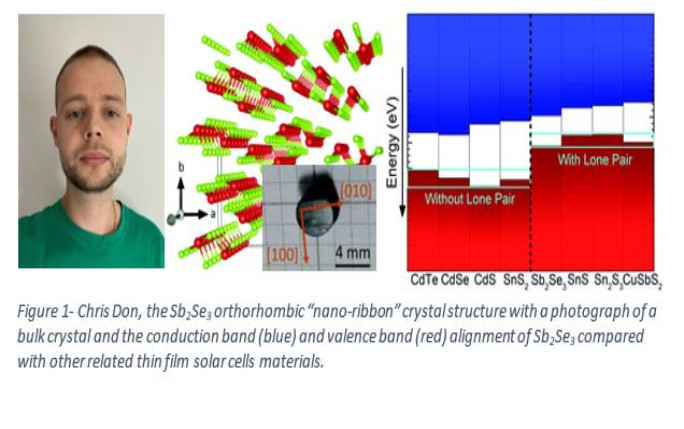BSc project student’s work results in publication on new solar cell material

In August, our paper titled: “Sb 5s2 lone pairs and band alignment of Sb2Se3: a photoemission and density functional theory study” was published in the Journal of Materials Chemistry C. This work was based on the BSc project work of the joint first author, Chris Don, who was supervised by Tim Veal in a project on analysis of photoemission data from the Diamond Light Source. Chris was the recipient of our HWB Skinner Prize in 2019. We are about to welcome Chris back after a year working as a Laser Test Engineer at Litron Lasers to begin a PhD in Physics within SIRE, supervised Jon Major, Asim Mumtaz and Laurie Phillips.
Chris says “When choosing my final year undergraduate project, I would never have imagined it would result in a published paper and a PhD studentship with the university. The experience my project gave me of sharing ideas and solving problems with the passionate PhD students and researchers at SIRE was incredibly valuable to me. I think this highlights the wealth of opportunities available within the physics department, even at undergraduate level. Having now nearly completed the first week of my PhD, where I am working with Jon Major developing tandem thin film solar cells, I am excited to be back at the university and am looking forward to the next four years of research at SIRE.”
As with several of our 2020 publications, this paper reflects the range of expertise within SIRE, from crystal growth by recently graduated PhD student, now postdoc, Theo Hobson with Ken Durose, to in-house photoemission spectroscopy from PhD student Huw Shiel (joint first author) within Vin Dhanak’s lab. As well as being an experimental collaboration within the SIRE, the work also makes use of density functional theory calculations performed by our collaborators at University College London. Comparison of the lab and synchrotron photoemission data with the theoretical density of states of the valence band revealed that the Sb 5s2 lone pair electronic states raise the valence band maximum with respect to that in materials with no such lone pair states. This has implications for the design of Sb2Se3 solar cell device structures. Sb2Se3 solar cells are an exciting emerging technology having progressed from 2% power conversion efficiency in 2014 to 10.5% in 2020, with devices made by Jon Major et al. in SIRE having reached over 7%.